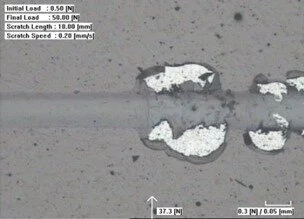GP Plasma introduces analytical materials design capability
We begin a series of articles about why coatings fail.
When I started in PVD coating development in the early 2000’s, large performance gains could be made by playing with composition and process to achieve relatively big gains in performance. But then it became increasingly difficult and I spent with a colleague 2 years and a few million dollars to increase overall coating performance by only 10-15%. Increasingly, customers are focused on niche market applications and want customized performance solutions to differentiate against competitors. Alternatively, short customer timelines leave the only recourse to take an existing coating and hope it survives the customers application testing. What I wanted was a development tool to give me visibility into the application and how those conditions would impact the needs of the coating properties to increase my chance of success and allow short timelines to be achieved.
“…Stress Destroys Materials, Measurement & Design Can Mitigate It!”
The traditional approach is experimentation and empirical testing validating against accelerated performance tests as close as possible to the application. These tests don’t always provide the resolution or information to properly design improvements, requiring specialized testing equipment in your market niche or development partnerships with your customers to work toward a solution. This process can take months or even years, is costly and may not end up in a sale. During this process you also run against the challenges of developing a production process that is robust to variation, where after several successful runs suddenly there is chipping, flaking, or delamination. This then creates compromises in performance as you try to mitigate by lowering the stress within the coatings or maximizing adhesion. While stress destroys materials, measurement and design can mitigate it!
Alternatively, finite element packages promised to provide modelling solutions to calculate performance, however, at these length scales, the performance is slow running from hours to days for simple designs, not easily reversible to work backward from desired solution to property requirement. Increasing the numbers of layers and adding thermal effects even more challenging while accounting for process variations (with weakened interfaces or stress variations) making them ineffective for industrial users.
GP plasma now has for its clients an analytical physics simulation tool for complex layered systems that is also scale independent [1]. A key strength is that it is a fully reversible analytical solution, meaning that you can start with the desired result and determine the properties needed, or start with what you have and determine if it will fail. By leveraging nanoindentation and scratch data, it collects information that allows it to determine the influence of microstructure and defects on the mechanical properties, and properly set up and design such tests to reduce uncertainty and collect information at the right position within a coating. In addition, it is capable of extracting the mechanical property profiles as a function of coating depth, such as Young’s Modulus, Yield, Intrinsic Stress and even Poisson’s ratio with the right measurement equipment. An example is shown of how adhesion testing can be optimized to place the maximum load at the interface rather than within the coating or substrate (left & middle image), or alternatively, the reverse is possible to ensure the worst case application loading will not place the maximum stress at the interface or within the substrate (right image showing scratch result after optimized film properties).
written by Troy vom Braucke



